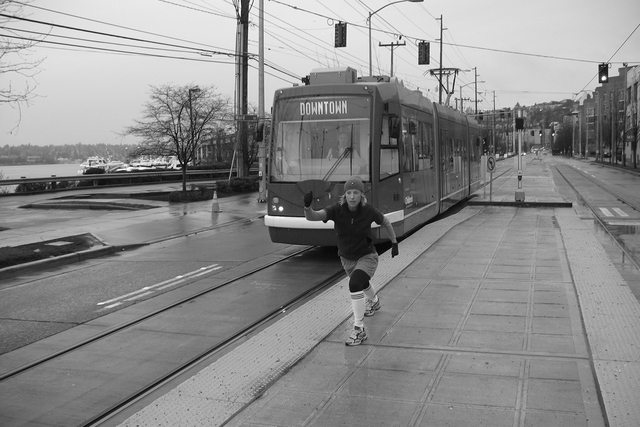With cigarette in hand and a bottle of Gatorade pressed against his crotch, Dave Marod squeezes his enormous yellow Hummer into a parking slip on Shilshole Bay Marina’s L-Dock at 7:45 on a cold Saturday morning in early March.
A trifle hungover, wearing dark shades, rubber overalls, a black fleece vest, and brand-new deck boots, the 37-year-old Marod exits the Hummer and laughs about what a favored target his rig has become for eco-conscious vandals who slap stickers on his bumpers. Best one to date: “I’m Changing the Environment. Ask Me How.”
Having descended the pier to slip 30, Marod loads a passel of gear onto his 35-foot Carroll Marine One Design sailboat, a premiere racing yacht that Marod scooped up for a cool $80,000 late last year. Greg Barckert was there when Marod started making waves about buying the boat during Whidbey Island Race Week last summer.
“We were up all night drinking and playing Grateful Dead covers when he mentioned the 1D 35-footer,” recalls Barckert. “That boat is like a Ferrari.”
“Dave’s got a really hot boat—people are looking to sail on it,” says Barckert’s friend and fellow sailor, Rachelle O’Haleck, who describes Race Week as “basically a five-day bender.”
When Marod made good on his drunken boast and announced plans to sail a 25-race campaign around the Sound, trimmers Barckert and O’Haleck signed up for two of nine available spots aboard the nautical Ferrari, named in honor of the seminal punk band Minor Threat.
Within 20 minutes of Marod’s arrival, the whole crew is present and prepped to shove off. All of these sailors smoke, save tactician John Knapp, Minor Threat‘s resident romanticist.
“Sailing is so many things,” says Knapp, a self-employed technology entrepreneur who sports a soul patch underneath his lower lip. “It’s going out with your girlfriend on a Sunday morning with a couple croissants. It’s dropping anchor in a beautiful lagoon in the South Pacific. Or it’s going like hell at 20 knots.”
But racing isn’t always romantic. “If you want to know what it’s like to sail competitively,” says crew member Tim Cleary, “stand in a cold shower for four hours and tear up $20 bills.”
Today, during this 27-mile race to Possession Point on the southern tip of Whidbey Island and back—the second in the Corinthian Yacht Club–sponsored Center Sound Series—the crew is in go-like-hell mode, as helmsman Marod didn’t drop all that dime to waste his Ferrari on a bunch of pleasure cruisers.
“Some of my friends like the solitude and being one with the ocean,” explains Marod. “All that shit’s fine, but I just want to beat the other guy and his expensive boat.”
With approximately 100 boats racing toward the lone turnabout today, Marod is competing in a top-tier class against just eight other vessels that are more or less in his “Ferrari” class. Still, there are enough variances for Corinthian officials to rank the boats according to the Pacific Handicap Racing Fleet (PHRF) system, a highly subjective standard that relies heavily on “observed performance” and “speed potential” rather than hard mathematical data.
“The bad thing is, when you cross the finish line, you don’t know how you did,” says Marod, alluding to the fact that a boat in his class that finishes behind him on a scratch basis may end up leapfrogging him in the final standings on account of being assigned a weightier handicap.
“I think it sucks that there are other factors involved other than the boat and the sailors in them,” grouses Knapp, who favors elite handicap-free racing to the PHRF system. “Handicap racing is good because it gets more people into racing, but it can sometimes get political.”
Take in a sailboat race from the shore or on television, and it’s “like watching grass grow,” concedes Marod’s fellow helmsman, drinking buddy, and sometime racing rival, Garey Harr.
But merely observing a crew in action from a spot aboard requires the onlooker to be intense, alert, and nimble enough to perpetually traverse the bow of the boat, as weight distribution is king on a hull as light as Marod’s.
“It’s like a roller coaster, and you’ve got to hang on,” explains Harr, a 47-year- old lifelong Ballardite and professional gardener who lives aboard a 27-foot Coronado at the Shilshole Marina. “If you fuck up, you capsize.”
While it’s not spectacularly gusty during the trip upwind to Possession Point, it is, after all, winter sailing, which means multiple layers of clothing for all but the silver-bearded crew member Cleary, who is either tough enough or stupid enough to weather the trip in khaki shorts.
Barking instructions from the middle of the bow in a vernacular unknown to land mammals is Wendell Gregory, a 58-year-old Texan who fell into the sport by default when, as an adolescent summer camper, he was forced to choose among horseback riding, archery, and sailing as his afternoon activity.
“It’s not much fun to shoot at a target that doesn’t move, and I can’t stand horses,” explains Gregory, who’s stayed hooked on halyards for upward of 40 years.
Dubbed “the Boat Whisperer” by Marod, Gregory’s job is “to pretty much read the wind” and advise the tactician and helmsman when to gybe—in lay terms, to shift sails for optimal wind velocity (see glossary, p. 29).
“He can put a boat on a straight line better than anyone I know,” Marod says of Gregory.
On the way to Possession Point, the Boat Whisperer performs this role with aplomb. On the way back, however, he differs with Marod as to whether to gybe back and forth or simply chart a straight course home. Ultimately, Marod defers to Gregory, a decision he feels cost him two or three places by the time his boat crosses the finish line by the yacht club, some four hours after they set out. Then again, it could have been the time spent strategizing on the fly that doomed the crew.
“If you wait more than a minute, you might as well talk about the next situation because that situation is gone,” explains Harr.
Gregory chalks it all up to Minor Threat‘s relative inexperience as a cohesive unit and is quick to note that there are boats racing out of Corinthian whose crews have remained intact for 20 years and counting.
“Our group is experienced, but not in this high-performance range,” he says. “It can take a whole year before you really learn the boat. We do have some really good sailors, though. We’ll jell eventually.”
“We did some great things out there today,” Barckert proclaims as fellow crew member Kris Lea tethers the boat to shore at race’s end. “We’re just starting to learn the boat. Sometimes you have to just throw out everything you know.”
“It’s all about teamwork,” Barckert adds weeks later over brunch near the Gasworks Park loft of his employer, North Sails. “The minutest difference between what you’re doing and what someone else on the boat is doing can be the difference between a great experience and a horrible one.”
But within the ranks of the yacht club and the Shilshole sailing community at large, nothing’s too traumatic for a 90-proof cure-all in an ice-packed tumbler.
“One of the best parts of racing,” says world-renowned yacht designer Bob Perry, “is those drinks after the race.”

THRILL OF the ABYSS
Marod and the Boat Whisperer met on the crew of a Ballard sheet-metal worker’s labor of love, a homemade 54-foot yacht called Union. After sailing the boat to and from Victoria, B.C., to participate in Memorial Day’s epic 36-hour Swiftsure Classic—a race from Victoria through the Strait of Juan de Fuca—the crew members refer to Union as the Death Trap.
“We lost control of the spinnaker, and it wrapped around this guy’s arm and peeled it like a banana,” recounts Gregory. “Another guy came off the mast like Errol Flynn and cut it [the spinnaker, not the arm] right off.”
“I’m on the radio with the Coast Guard the whole time, and I’m like, ‘We’re OK, we’re OK,'” adds Marod, displaying competitive sailing’s finish-or-drown ethic. “They’re basically laughing on the other end, saying, ‘You’re not OK!'”
“We did $30,000 worth of damage in 30 seconds,” adds Gregory, accounting for comprehensive damages including, but not limited to, the trashed spinnaker. “That’s how I met Dave.”
While most sailors carry insurance that will cover such mishaps, owning a one-design boat is a financial sinkhole for all but a finite number of America’s Cup–caliber professional sailors with corporate sponsors. Echoing Tim Cleary’s cold-shower analogy, Forbes called yacht racing the most expensive sport in the world in 2004, well ahead of polo and vintage airplane racing, leaving readers with the following pearl: “If a sailboat is a hole in the water into which one pours money, a racing yacht is an abyss.”
“It’s not for the financially meek,” acknowledges Marod, who, barring the unlikely event that he one day captains a professionally crewed boat with corporate sponsors, will never see a penny’s worth of return on his investment.
A technology salesman who likes his toys—he also owns a Motocross bike and bought a superfast crotch rocket for civilian purposes recently, the day he signed his divorce papers—Marod is not bothered by the notion that people are apt to dismiss such indulgences as materialistic, egomaniacal frivolities (don’t forget that Hummer, either). But the sailboat he’ll defend tooth and nail.
“Family and friends understand it’s my passion, but at the same time they’re like, ‘Holy shit, you idiot,” explains Marod. “But the people I sail with get it. It’s one thing to get up and sail around; it’s another thing to get a $100,000 boat with a nine- or 10-person crew and race other $100,000 boats.”
Consider also that Marod is a Navy veteran who was reared a block from Lake Michigan in Grand Haven, Mich. (he moved to Seattle in 1992 shortly after a stint in the first Gulf War). When other kids hit the baseball diamond or soccer field, wee Dave headed for the lake. And when his fellow Michigan State University alums split for brokerage firms or grad school, Marod again took to the sea, this time in service to his country.
“For some people, having a boat is like being a musician,” says yacht designer Perry, who, as a member of the rock band Scratch, is intimately acquainted with both impulses. “You don’t really have an option. People will lead really modest lives offshore and have a boat. It becomes a centering device for their lives.”

Perry’s words ring especially true for a cadre of blue-collar sailors who live full time on their boats at Shilshole Marina, a city unto itself that features a healthy contingency of mug-hoisting, happy-go-lucky types who rarely leave Ballard—except, of course, by sea. Foremost among these characters is Garey Harr, a handsome, diminutive gardener who has never lived outside the neighborhood boundaries.
“My brother used to call Ballard the white ghetto,” recalls Harr. “You used to do the Ballard Avenue pub crawl, and it was all fishermen. Not anymore.”
Shortly after graduating from Ballard High School, Harr moved into a small house on Seaview Avenue across from Ray’s Boathouse. Among his neighbors was a talented, hard-drinking young sailor named Arnie Hammer, who recruited Harr to join his crew and gave the gardener his first taste of how hard-core Shilshole yacht racers could be.
“The scariest thing I ever did was when Arnie made me put up a kite in 45-knot wind,” says Harr, noting that such a maneuver in high winds is more than sufficient to turn a boat on its head. “He just kept saying, ‘Get it up! Get it up!’ I was like, ‘We’re gonna die, but this is pretty cool.’
“The day I told Arnie I couldn’t sail seven days a week,” Harr adds, “he kicked me off the boat.”
The peak of Harr’s career came when he sailed competitively on 50-foot boats with “guys who are all in America’s Cup now.” The lone time he made it to the World Championships off the Oregon coast, Harr’s boat fouled at the start, broke a rudder, and eventually capsized.
Nowadays, Harr serves as helmsman for a 29-foot boat owned by Pat Denney, who, not too long ago, offered it up as living quarters when Harr broke up with a longtime girlfriend. While Denney’s vessel is a wonderful little race boat, it was ill-equipped for full-time occupancy (read: really fucking cold). Still, Harr found a way to make the arrangement work before buying a homey 27-foot Coronado off eBay for $2,900. “I’d only go to Pat’s boat to sleep,” says Harr. “The rest of the time, I was off at a bar.”
This meant frequent trips to the nearby Sloop Tavern, a clubhouse of sorts for local sailors that has its own full-fledged yacht club and sponsors a 22-event series—including the weekend-long “Race to the Straits” that coincides with Seattle Yacht Club’s Opening Day (Saturday, May 6).
“Saturday, you race up to Port Townsend, and we have a big party there,” says Sloop Tavern Yacht Club commodore and Shilshole live-aboard Kirk Utter. “And Sunday morning, you race back to Seattle. We’ll have over 100 boats.”
“That’s the best race of the year,” says Harr. “Then there’s the Garey Harr Yacht Club. All you have to do is buy a few drinks, and you’re in. Very informal there.”
YACHT RACING’S SCHIZOPHRENIA
In the basement of Seattle Yacht Club on a tranquil, drizzly Portage Bay morning, a food-service worker is spreading white linen over a banquet room table. In the surrounding corridor is a collection of framed, mounted plaques and photos from regattas of yore, as well as event calendars for junior sailors, Women’s Group, and clubwide socials like the annual Animal House Party, where everyone dresses up in togas and drinks alcohol-flavored punch.
“Do you know where the silver polish is?” the worker inquires of no one in particular.
Down the hall, the club’s sailing director, Brian Ledbetter, arrives, coffee in one hand, fruit salad in another, and a satchel slung over his right shoulder. His spartan office boasts no water views, and one must wade through a rack of monogrammed tie-dyed T-shirts to make it to his desk. In short, this glorified storage closet does a fine job of concealing Ledbetter’s all-world stature in the rarefied world of professional sailing.
A silver medalist in the 1992 Barcelona Olympics, Ledbetter was part of telecommunications baron Craig McCaw’s bid to snatch the 2003 America’s Cup from the Kiwis. McCaw, with a $10 million assist from Paul Allen, sank some $80 million into the effort, recruiting 16 of the best sailors in the world to crew his 80-foot hull, among them Ledbetter and Seattle’s McKee brothers, Jonathan and Charlie, who took home bronze in the 2000 Sydney Games.
After a public feud with fellow new-economy tycoon and yachting enthusiast Larry Ellison over design secrets, McCaw’s bid failed spectacularly, a chunk of his fortune sunk in the abyss.
With its upper ranks spoiled by pay-to-play novices like McCaw, Ellison, and Allen, it’s no wonder America’s sailing rank and file have sought to essentially extricate the term “yacht” from the sport’s stateside vocabulary.
“The U.S. Yacht Racing Union changed its name to U.S. Sailing just to get rid of the snooty elitism,” says John Knapp. “In other parts of the world, there’s none of this. In Australia, if it’s a yacht, it’s a sailboat.”
“It’s only a yacht if you’re selling it or trying to get laid,” quips Chuck Stephens, an affable Ballard sailor who serves as rear commodore of the Shilshole Bay Yacht Club, which co-sponsors the annual 15-race Ballard Cup series in conjunction with its workaday next of kin, the Sloop Tavern Yacht Club.
For his part, Seattle Yacht Club’s Ledbetter grew up sailing in the junior program at San Diego Yacht Club, home to America’s Cup hero Dennis Conner and considered by many to be America’s competitive sailing nexus.
“It’s kind of the same as dirt tracks and NASCAR,” Ledbetter says of his progression from peewee to pro. “I had a good base because San Diego Yacht Club had a great junior program.”
After the Barcelona Olympics, Ledbetter moved to his wife’s native Seattle and worked as a real-estate broker before becoming the club’s sailing director a little over a year ago.
“Sailing is kind of uncomfortable here,” says Ledbetter, who acknowledges being spoiled by sun as a young San Diegan. “But it’s all the same with the right amount of Gore-Tex.”
Ledbetter’s informal tour of his yacht club’s quarters winks at the schizophrenic nature of the sport. Upstairs, the club offers the sort of ascot and blazer accoutrements that would make Judge Smails and Secretary Cleary feel right at home. But down on the docks, SYC’s junior director, Craig Guthrie, is dressed in sweatshirt and jeans, scrubbing the grime off a beached dinghy. Guthrie, like Ledbetter, sounds an awful lot like a surfer dude. For that matter, so does Garey Harr.
When asked if he knows who Harr is, Ledbetter replies in the affirmative. Then he asks if his pal Garey is still helming Pat Denney’s 29-footer down at Shilshole, revealing the thin line between pro and skilled amateur in the competitive yacht racing world—a world where whatever financial stratification exists between sailors gets checked at the bow.
“I’ve known people for years and haven’t asked them what they’ve done for a living, and vice versa,” says Harr. “They don’t treat me any different because I’m a gardener, and I don’t treat them any different because they’re a lawyer.”
This isn’t to say the sport is without its pecking order. When Marod, who’s been crewing other people’s boats competitively for over a decade, walked into the Sloop recently, he was approached by a trio of rival sailors who asked him what state he just came in from with that One Design of his. Marod explains that, sometimes, sailors don’t get the recognition they deserve until they helm a boat of their own.
“Sailing is a way for me to make a name for myself in this town and not live in ambiguity,” says Marod. “There are circles within circles in the sailing community. There are sailors in general, and there are individual yacht clubs. Then there is a circle with high-performance boats, hot sailors, and really cute girls.”

SALTWATER AND A CENTERED LIFE
Yacht designerBob Perry rubs his chopsticks together over a steaming bowl of what he calls “street noodles” at the Szechuan Bean, a cheap, delicious, and aesthetically drab restaurant near the Oak Tree multiplex on Aurora Avenue North. That Perry speaks Chinese to the maître d’ is no accident: To date, he has presold 80 of his latest Chinese-manufactured cruising yacht, the Flying Tiger, at the low, low price of $44,500 a pop.
“That’s less than half of what an American-made boat would cost,” says Perry, a tall, bearded tobacco-pipe enthusiast who drives a 14-year-old Mercedes-Benz and favors classical music when he’s not moonlighting as a bassist in an area rock band.
While Perry designs all types of newfangled craft in his small Phinney Ridge studio—including “a $6 million submarine for the guy who’s not Bill Gates”—he’s still best known for his very first sketch, the Valiant 40-foot, the granddaddy of performance cruisers, which is in the Boat Building Hall of Fame.
“I’ve got 300 different designs and 6,000 boats on the water, last I counted,” says Perry, who has clients all over the world. “But I’ll forever be associated with the Valiant 40-foot.”
Before moving his operation across the street from the Woodland Park Zoo around the turn of the century, Perry occupied a building along Seaview Avenue near the Shilshole Marina, and he’s participated in several Corinthian races, not to mention three Swiftsure Classics.
“I think the deal there is to prove you can do it,” Perry says of the British Columbian marathon. “It’s a little like mountain climbing: There’s a satisfaction that comes with conquering adverse conditions.”
But that’s not the half of it.
“Sailing is an incredibly unifying thing,” adds Perry, who lives within walking distance of the marina. “I can bump into a sailor anywhere in the world and have a lot in common. Parachute me in wherever there’s saltwater and I’ve got instant friends.”
Marod stands in concurrence.
“I went down to San Diego, and you should have seen all the Seattle guys down there,” he says. “You go down to Florida, and you know the boats and their owners. It shrinks the world.”
For live-aboards, this observation carries a double meaning.
“It’s not so nice in the cold, rainy winter, but it’s extra nice in the summer,” says Knapp, who lived aboard a vessel at the Elliott Bay Marina for four years before moving to downtown Ballard. “It forces you to live consciously with possessions—maybe give away the dining room table. Now I live in what some people would consider a small studio apartment.”
“A big part of this is being immersed in the culture,” says Rachelle O’Haleck, who lives aboard Wendell Gregory’s boat on Shilshole (the Boat Whisperer rents an apartment near the locks for himself). “One thing I’ve noticed about living aboard is you conserve. I can only carry 25 gallons at a time and have to boil my own hot water.
“There’s not a lot of primping going on,” she adds. “Either you’re a natural beauty or you’re out of luck.”
On a brilliant Saturday afternoon two weeks after the Possession Point race, most of the Minor Threat crew is fraternizing on the dock below the CYC clubhouse, drinking Red Hook by the pitcher and trying to find the silver lining in yet another eighth-place finish in the finale of the Center Sound Series. It’s a little easier this time. By all accounts, things went a lot better today, thanks in no small part to Greg Barckert, who recruited a couple stellar bowmen to augment Marod’s original roster of talent. (Minor Threat would go on to finish second in CYC’s Puget Sound Spring Regatta on April 8 and 9).
Jovial, relaxed, and at the side of his latest sailor-girl love interest—”It was love at first sight when I saw her on the dock with a traveler of Scotch the morning of a race”—Marod has thus far dodged the postrace rum tornado that transformed him into Boozo the Clown last time out. As Marod freshens his girlfriend’s pint glass, a newcomer remarks that the main barroom upstairs reeks of sweaty sailors, wet dogs, and stale beer.
“I love those smells,” Marod replies, before heading down the street to his Sound-front flat, where a stack of 20s awaits him in the shower.










